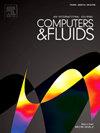Effect of Serpentine Flow Field Channel Dimensions and Electrode Intrusion on Flow Hydrodynamics in an All-Iron Redox Flow Battery
IF 2.5
3区 工程技术
Q3 COMPUTER SCIENCE, INTERDISCIPLINARY APPLICATIONS
引用次数: 0
Abstract
This paper presents a study on flow hydrodynamics for single-channel serpentine flow field (SCSFF) and cross-split serpentine flow field configurations (CSSFF) for different geometric dimensions of channel and rib width ratios with electrode intrusion over varying compression ratios (CRs) in an all-iron redox flow battery. Pressure drops (Δp) measured experimentally across a cell active area of 131 cm2 for different electrolyte flow rates were numerically validated. A computational fluid dynamics study was conducted for detailed flow analyses, velocity magnitude contours, flow distribution, and uniformity index for the intrusion effect of a graphite felt electrode bearing a thickness of 6 mm with a channel compressed to varying percentages of 50%, 60%, and 70%. Experimental pressure drops (Δp) over the numerical value resulted in the maximum error approximated to 4%, showing good agreement. It was also reported that the modified version of the cross-split serpentine flow field, model D, had the lowest pressure drop, Δp, of 2223.4 pa, with a maximum uniformity index at the electrode midplane of 0.827 for CR 50%, across the active cell area. The pressure drop (Δp) was predominantly higher for increased compression ratios, wherein intrusion phenomena led to changes in electrochemical activity; it was found that the velocity distribution was quite uniform for a volumetric uniformity index greater than 80% in the felt.蛇形流场、通道尺寸和电极侵入对全铁氧化还原液流电池流体力学的影响
本文研究了全铁氧化还原液流电池在不同压缩比(CRs)下,在不同几何尺寸的通道和肋宽比下,单通道蛇形流场(SCSFF)和交叉分裂蛇形流场构型(CSSFF)的流体力学特性。压降(Δp)在131 cm2的电池活性面积上的实验测量得到了不同电解质流速的数值验证。通过计算流体动力学研究,对厚度为6 mm的石墨毡电极进行了详细的流动分析、速度大小轮廓、流动分布和均匀性指数,并将通道压缩到50%、60%和70%的不同百分比。实验压降(Δp)在数值上的最大误差接近4%,显示出很好的一致性。另据报道,改进型的交叉分裂蛇形流场模型D的压降最低,为Δp,为2223.4 pa,当CR为50%时,整个活性电池区域电极中部均匀性指数最大,为0.827。压降(Δp)主要随着压缩比的增加而增大,其中侵入现象导致了电化学活性的变化;结果表明,当毛毡的体积均匀度指数大于80%时,毛毡的速度分布相当均匀。
本文章由计算机程序翻译,如有差异,请以英文原文为准。
求助全文
约1分钟内获得全文
求助全文
来源期刊

Computers & Fluids
物理-计算机:跨学科应用
CiteScore
5.30
自引率
7.10%
发文量
242
审稿时长
10.8 months
期刊介绍:
Computers & Fluids is multidisciplinary. The term ''fluid'' is interpreted in the broadest sense. Hydro- and aerodynamics, high-speed and physical gas dynamics, turbulence and flow stability, multiphase flow, rheology, tribology and fluid-structure interaction are all of interest, provided that computer technique plays a significant role in the associated studies or design methodology.
 求助内容:
求助内容: 应助结果提醒方式:
应助结果提醒方式:


